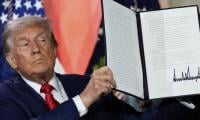In the end, we achieved nothing. In fact, we are much worse off than we were since the pandemic hit us in mid March.
We have failed to contain the spread of the virus, which is reflected in the ever growing number of people who have been infected and the rising number of deaths. Not just the experts but the federal government also believes that we are far away from the peak of this pandemic.
As for the economy, crippling effects are being felt by every segment of the population. Indeed the federal planning minister has acknowledged the devastating consequences. According to the minister, between three crore and seven crore people will go below the poverty line and about 18 million people will lose their jobs as a result of the economic impact. And about one million small enterprises will go bankrupt, according to the minister.
These are staggering numbers and more or less sum up the devastation caused to the economy as a result of the government’s indecisiveness on whether to lock down or not. Some of the economic consequences were natural and expected as the virus hit Pakistan but the extent of the damage could have been contained, especially considering the PM never wanted a lockdown.
It was always going to be a difficult decision: to choose between health and economic considerations. Every government in the world had to make this choice. Pakistan was no exception. But in fighting this pandemic, we did make an exception to international best practices – rather, several exceptions. Let me explain how.
From the beginning, the PM was never convinced on the lockdown strategy. Except for Sweden, all countries went for a strict lockdown, including China and almost all third world countries. But the PM thought the world was wrong, especially the poor third world countries. Even in his first speech to the nation, he tried to downplay the seriousness of this virus. In his typical manner, he was trying to explain that this virus does not affect the young population.
Taking a leaf out of US President Donald Trump’s logic, the PM compared it with a normal flu. He bitterly criticised the Sindh government’s decision to impose lockdown – a decision that according to the PM was taken in haste; he called it an act of cowardice. If at all, we needed to demonstrate unity, this was the time. If nothing else, we would have had less confusion than what we now see. So even though the federal government reluctantly imposed a lockdown, it never strongly implemented it even in provinces where the PTI is ruling.
The PM even criticised the Indian PM for imposing a lockdown without taking into consideration the plight of the poor Indian masses. He went after the elite who he thought was responsible for enforcing a lockdown without due consideration of the poor masses. He never explained or clarified who this elite is which can make key national decisions with far-reaching implications without the consent of the PM.
In countries where restrictions have been relaxed after weeks of strict lockdown, very clear milestones have been defined. The relaxation only came after the countries reached what is called ‘flattening of the curve’, basically meaning that the virus has peaked and starts a declining trend. As the restrictions are relaxed, the governments in all countries ensured significant increase in testing – almost a mandatory condition to ensure that infected people are separated from the normal population.
What did Pakistan do while announcing the relaxation? We are far away from the ‘flattening of the curve’, meaning we have not yet reached the peak of the virus. According to most experts, the peak will be reached somewhere around end May or beginning June or even maybe end June. The government believes the peak will be reached earliest May end.
In a period when the curve is still going up, relaxing restrictions means exposing the population to dangerous health implications. In a way, the government has left it to the people to ensure their own safety while the government looks the other way. Also, there has been much talk of increasing the testing rate, but so far the numbers tested are far shorter than the situation demands. In short, the federal government has announced the easing of the lockdown without necessary prerequisites.
Looking back, we have simply wasted the last 6-7 weeks. There was hardly any lockdown in any part of the country. People were gathering in large numbers for the most part of this period – except for Sindh, where we saw the provincial government making efforts to impose its writ. In other provinces ruled by the ruling party, there was not even an effort, not even a semblance of a lockdown; people were simply allowed to gather in large numbers. On the contrary, several federal ministers were seen openly encouraging small traders and shopkeepers to defy the restrictions in Karachi and the rest of Sindh.
All through the last several weeks, a case was being built to inform the nation of the devastating economic hardships as a result of the lockdown. All we saw were dozens of press conferences by the PM and senior federal ministers telling us what was already known.
If the lockdown was not a good strategy as the PM had taken pains to inform us, why then the lockdown? On the one hand, Sindh was criticised for imposing a lockdown but then why was Sindh's example followed in other provinces? If the PM and his team believed that an economic downside would not be sustainable and would have far-reaching consequences, then why was the lockdown imposed ? And that too in a manner with no effect to avoid large gatherings. What did we actually achieve by such half-hearted efforts?
Clearly, we could not achieve any of the objectives – the coronavirus is spreading faster than at any time since Pakistan was first affected by this disease, while the economy has completely collapsed. Unemployment is at an all-time high while more people live below the poverty line than at any time in recent memory. Federal tax collection has deteriorated to the level where even the basic needs of the government are difficult to be met. And, most important, the public is totally confused as to where we are heading.
The writer is former governor Sindh and former minister for privatisation.















